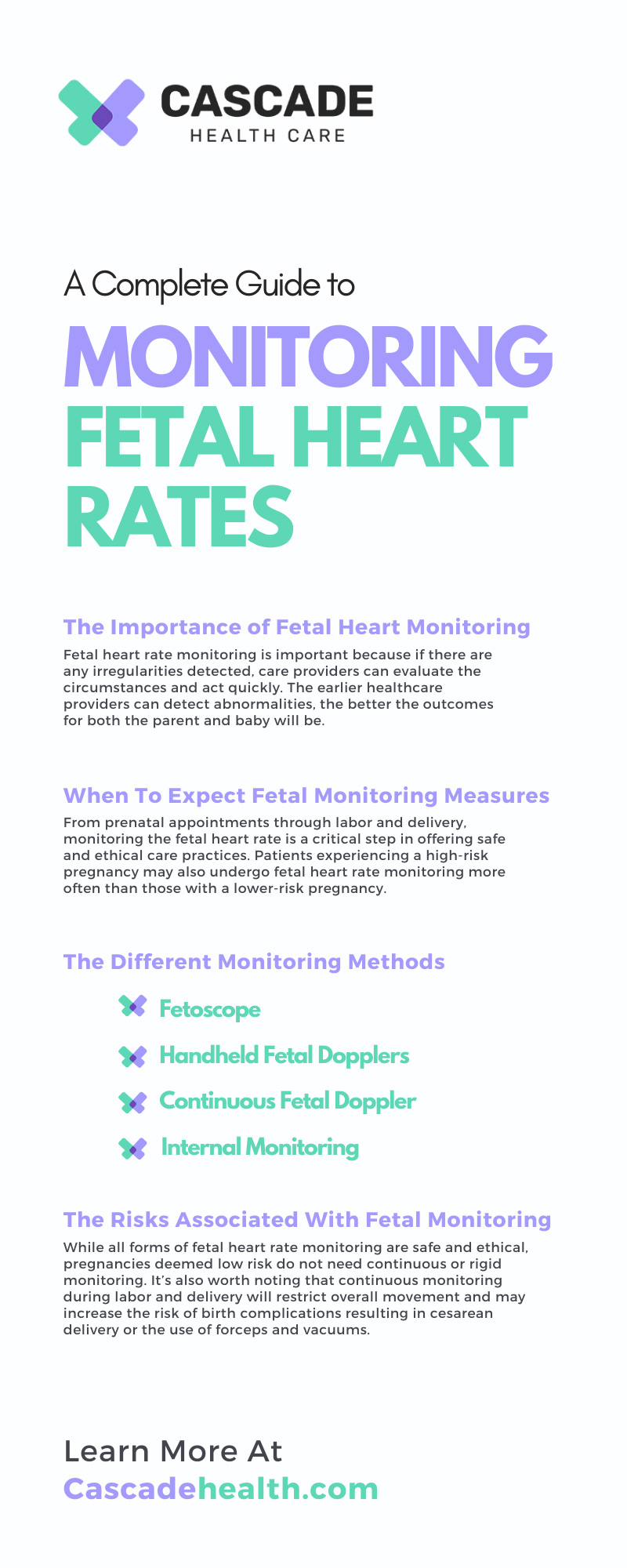A Complete Guide to Monitoring Fetal Heart Rates
Outside of ultrasound, there aren’t too many other ways to ensure the health and well-being of a fetus. Care providers will often rely on fetal heart rate monitoring through various stages of pregnancy and delivery to obtain the information they need to ensure fetal viability. While an ultrasound may offer a closer look at physical growth, fetal heart monitoring can offer immediate peace of mind surrounding heart and lung development.
Because there are various devices used for monitoring, it’s worth exploring all there is to know about the process and why it’s important. We created this complete guide for monitoring fetal heart rates and exploring the devices and risks associated with the process.
The Importance of Fetal Heart Monitoring
Fetal heart rate monitoring helps providers understand the pattern and the speed of a fetus’ heart. This matters when offering prenatal care, as the heart’s rhythms can indicate overall fetal viability. In-utero, the average heart rate range is between 110 and 160, with trends between 120 and 150. Monitoring and measuring with a professional-grade medical device can help care providers understand if the rate is too low or too high, and the results will help them offer optimized patient care to the expecting parent and the fetus.
It’s worth noting that an expecting parent’s anxiety or current state of mind may cause the fetal heart rate to fluctuate. If the fetal heart rate fluctuates between six and 25 beats within a 10-minute period, this is normal and not a cause for significant concern.
Fetal heart rate monitoring is important because if there are any irregularities detected, care providers can evaluate the circumstances and act quickly. The earlier healthcare providers can detect abnormalities, the better the outcomes for both the parent and baby will be.
When To Expect Fetal Monitoring Measures
Monitoring is not explicit to one specific time or space; healthcare providers rely on it throughout an expecting parent’s journey. From prenatal appointments through labor and delivery, monitoring the fetal heart rate is a critical step in offering safe and ethical care practices.
Patients experiencing a high-risk pregnancy may also undergo fetal heart rate monitoring more often than those with a lower-risk pregnancy. High-risk pregnancies can stem from various health conditions, from pre-eclampsia, diabetes, gestational diabetes, and bleeding issues. It’s essential to note that a high-risk pregnancy can result from a range of health conditions. Careful consideration and monitoring can help a patient manage the pregnancy and its outcomes.
The Different Monitoring Methods
There are a range of methods that a provider may use to monitor the fetal heart rate, from external to internal devices. Each device serves a fundamental purpose, and the provider may choose the most appropriate one based on the prenatal stage or health-related concerns. There are manual and electronic devices available, and we explore these below.
Fetoscope
Fetoscopes are relatively similar in shape and function to a fetal stethoscope. These are non-electrical devices that require more training and experience to ensure accuracy. The cone-shaped device can listen to heart and lung rhythms by pressing the cone on the expecting parent’s abdomen. Because these instruments are non-electrical, they carry zero side effects or risks and are medically safe to use with adequate training.
Handheld Fetal Dopplers
Handheld fetal dopplers are a common device found in many medical and birth spaces. These are electronic instruments with a probe device and a monitoring screen, and a provider uses a gel to administer the exam. Providers will apply the specified gel to the expecting parent’s abdomen before placing the probe. The doppler uses sound waves to detect internal rhythms and translates the findings on the handheld monitoring screen. Handheld devices are available to purchase online for patients to use at home, though we don’t advise this.
Continuous Fetal Doppler
Continuous fetal heart rate monitoring occurs during labor and delivery. There are a range of factors that may require a provider to complete these monitoring methods. Continuous fetal monitoring is also an electrical form of monitoring that places a measuring probe onto the expecting parent’s abdomen with an elastic strap. The elastic strap serves as a placeholder for the device. A second elastic strap holds the measuring device that monitors contractions. Expecting parents must remain in their seats or beds while connected to continuous fetal monitoring setups as the device’s wires run to an additional external computer monitoring system.
Internal Monitoring
In rare cases, providers may find it necessary to monitor the fetal heart rate after the water breaks and before delivery. This may require internal monitoring measures, which means providers will place a measuring device on the fetus’ head and continuously monitor internal rhythms. Internal monitoring is not common but is essential when external becomes unreliable.
The Risks Associated With Fetal Monitoring
While all forms of fetal heart rate monitoring are safe and ethical, pregnancies deemed low risk do not need continuous or rigid monitoring. It’s also worth noting that continuous monitoring during labor and delivery will restrict overall movement and may increase the risk of birth complications resulting in cesarean delivery or the use of forceps and vacuums. Internal monitoring also comes with small risks, including infection or injury to the fetal scalp.
A Note About Home-Based Fetal Monitoring Devices
As we mentioned above, those who want it can access home-based fetal heart rate monitoring devices. But it’s vital to understand that monitoring the fetal heart rate without adequate training and education may induce fear or anxiety, further increasing the amount of risk associated with electronic devices.
These home-based devices are not necessary when in the care of a medically trained and licensed provider. If you’re concerned about the health and well-being of your baby, partner with your preferred provider to seek guidance.
A Note About Fetal Monitoring With Mobile Device Apps
In addition to home-based fetal dopplers, many users find a range of monitoring apps on their mobile devices. You should avoid these when possible. In general, a mobile device does not have the technology needed to detect internal heart and lung patterns accurately. Because of this, mobile apps often relay no results or inaccurate information, leading to fear and anxiety for the expecting parent(s).
Cascade Health Care understands the importance of offering this complete guide to fetal heart rate monitoring. It’s essential to choose the most appropriate measuring devices and know how to use them. Shop our comprehensive inventory of monitoring devices and partner with a member of our trusted team for questions.

Recent Posts
-
Exploring Recent Innovations in Doppler Signal Processing
Doppler technology has become an essential diagnostic tool in modern medicine, enabling healthcare p
-
Exploring Recent Innovations in Doppler Signal Processing
Doppler technology has become an essential diagnostic tool in modern medicine, enabling healthcare p


